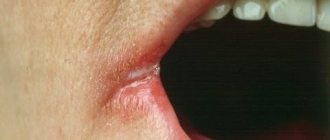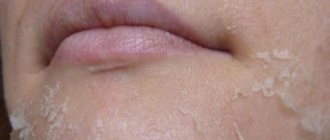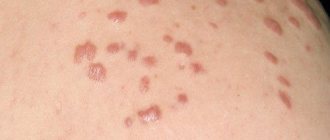The skin on the nipples is dry. Why do my nipples peel?
Peeling nipples are one of the problems that women often face.
This can be due to many reasons and occurs regardless of the woman’s age and condition. In any case, if nipple peeling or itching occurs, you should consult a doctor to find out exactly why your nipples are peeling. You can tell your gynecologist or mammologist about this problem. Peeling nipples are not always associated with a serious illness. It often goes away on its own and does not require special treatment. However, if peeling begins to seriously bother you and is also accompanied by itching, then it would be a good idea to consult a specialist.
Why do women's nipples peel?
Let's look at why the nipple skin peels. There may be several reasons for this:
- Pregnancy. During pregnancy, the whole body is rebuilt, the breasts at a certain period begin to fill with milk, the skin stretches, and therefore peeling and often itching occurs. However, if your chest itches constantly and this causes serious discomfort, you should definitely consult a doctor.
- Urticaria. At the same time, the skin becomes mottled and itchy.
- Dermatitis (usually contact). Perhaps the fabric from which the underwear is made causes allergies.
- Chemical irritation. Such irritation will manifest itself not only as peeling, but also itching, rashes, swelling, and a burning sensation. A crust may even appear on the surface of the breast.
- Allergy. Such an allergic reaction can occur, for example, to certain chemicals. Often a similar reaction can be observed to body care products (creams, shampoos, soaps, balms, etc.). This may result in an allergy to the washing powder used to wash clothes.
- Eczema. This is a serious dermatological disease that requires mandatory treatment by a skin specialist.
- Lack of moisture in the body. When there is a lack of fluid, the first sign is dry skin. In this case, the mucous membranes and skin around the nipples dry out first, which causes peeling.
- Hormonal changes. Peeling on the nipples most often occurs in the second half of the menstrual cycle, that is, when menstruation approaches. Sometimes peeling occurs during ovulation (that is, in the middle of the cycle), when the breasts swell, the skin stretches and peeling appears.
- Lack of vitamins. Hypovitaminosis is one of the common causes of peeling of the skin, and on the chest in particular.
- Breast diseases (especially if there is atypical discharge from the nipples).
- Breast growth in girls during adolescence.
Medical diagnosis and examination
A diagnostic examination is prescribed by a doctor from the moment a woman seeks help. Further examination involves an examination by a doctor who palpates the mammary glands for the presence of hardening and the absence of tumors and interviews the patient in order to collect the necessary information about the cause of dry nipples for further diagnosis.
The following tests may be prescribed:
- Biopsy - prescribed if the presence of malignant tumors is suspected, involves taking fluid from the nipple.
- Submission of laboratory tests (blood and urine) to identify the cause of the inflammatory process in the body and why the skin peels.
- Taking blood tests for hormones - helps to determine pathological changes in hormonal levels
- Conducting a blood test for the presence of a bacterial infection, allergen or inflammatory agent.
- If a candidiasis infection is suspected, the gynecologist takes a smear to check for candidiasis.
- To diagnose oncology, tests for tumor markers will be required.
In some cases, specialists decide to conduct instrumental diagnostics. This helps to specify the diagnosis and prescribe the correct treatment.
Common instrumental diagnostic methods are:
- Ultrasound of the mammary glands helps clarify the diagnosis, duration and stages of development of the disease. It is prescribed to identify tumors, benign neoplasms and cysts. The procedure allows you to determine the location of the disease.
- Mammography is a method that examines the condition of the mammary glands.
- MRI – specifies changes in the breasts and nipples. Diagnoses the type of tumor.
- Echography is one of the current methods that allows you to determine the condition of the ducts of the mammary glands.
The use of accurate diagnostic methods makes it possible to identify the disease at an early stage and lead to the cause of how it began.
The skin on the nipples peels off during guarding. Peeling on the nipples: causes, possible diseases, treatment
The epidermis of the breast reacts sharply to any irritants, so many women suffer from flaking skin on their nipples. Most often, a defect appears for completely harmless reasons and causes inconvenience only from an aesthetic point of view. But sometimes the problem is a signal of a serious pathology.
Main causes of dry breast skin
You need to understand that along with allergies, not only peeling appears near the nipples, but also red spots all over the body, which almost always itch.
First of all, you need to keep in mind the following possible reasons:
- Pregnancy and lactation. In the later stages of pregnancy, a woman secretes colostrum from her nipples in small portions. It dries quickly, leaving a feeling of tightness. During feeding, the baby actively sucks at the breasts, damaging thin skin and leaving microtraumas.
- Allergy. Sources of allergens usually include cosmetics and detergents, chlorinated water, washing powder, and synthetic fabrics. A reaction to food is also possible. In response to irritation, the skin becomes scaly and itchy.
- Water imbalance. When there is a lack of fluid in the body, the most sensitive areas of the epithelium begin to dry out first. In this case, you need to drink plenty of water and avoid diuretics.
- Avitaminosis. Lack of vitamins and microelements has a detrimental effect on appearance. Nails and hair suffer along with the skin. If the problem is hypovitaminosis, the woman experiences decreased performance and chronic fatigue.
- Breast growth. Girls often notice peeling nipples before menstruation. The fact is that during this period the production of progesterone increases. The hormone causes the mammary glands to swell, causing the skin to stretch and become damaged. A similar process occurs during puberty, when taking hormonal contraceptives, and also during pregnancy.
- Unbalanced diet. An excess of sweet, spicy, smoked, and alcoholic foods leads to the accumulation of a large number of irritants in the blood. Nipples and areolas react to toxins by becoming dry and tight.
The most common causes include pregnancy, lactation and hormonal changes.
Peeling nipples as a sign of disease
Sometimes dry breast skin indicates the development of a disease. These can be dermatological diseases and pathologies of internal organs, including oncology:
- Eczema. A dermatological disease characterized by the appearance of scaly foci of inflammation. Patients are bothered by severe itching and burning. Similar symptoms occur in people suffering from psoriasis and dermatitis.
- Diabetes. Disruption of the endocrine system, consisting in problems with the absorption of glucose. The disease is accompanied by severe dry skin, hunger and thirst that cannot be suppressed, sudden weight loss, and profuse purulent rashes.
- Thrush. Many are accustomed to thinking that this disease affects only the genitals, but this is not so. Fungi can multiply on any mucous membrane if favorable conditions are created for them. Nursing mothers often suffer from candidiasis. Pathogenic microorganisms enter the breast from the baby's mouth, causing flaking of the skin on the nipples, itching, rash and severe pain during feeding.
- Mastitis. Inflammation of the mammary gland. Usually affects nursing women. With the disease, breast swelling, the appearance of compactions, and an increase in local temperature are observed. Redness and dryness appear, and pus is released with milk.
- Inflammatory cancer. The symptoms resemble mastitis. The tissues become deformed and resemble lemon peel in appearance. The nipple retracts and a feeling of heaviness appears in the chest. Local lymph nodes become inflamed, and general signs of intoxication are observed.
- Armor cancer. It is characterized by a reduction in the mammary gland and its upward displacement. Redness affects the entire chest, armpit and arm. The chest tightens, breathing becomes difficult. Erosion and cracks appear around the nipple.
- Paget's disease. A form of oncology affecting the nipple. The first symptoms include redness and irritation. There is peeling of the nipple areola. The nipple itself becomes flat and tight. Numerous ulcers and erosions form. Local lymph nodes become enlarged and serous or bloody discharge appears.
- Ductectasia. Pathological enlargement of the milk ducts. The condition itself is not dangerous, but it can be a sign of a serious illness. Manifests itself in the form of compactions in the peripapillary area, itching, burning, and swelling. The nipple moves to the side and secretes an unknown fluid.
- Melanoma. It looks like a birthmark. You can understand that this is not just pigmentation by peeling, a sharp increase in size and bleeding.
The skin on the nipple and areola can peel off for a variety of reasons. If nothing else bothers you other than the appearance of scales, then you don’t have to worry. The appearance of pain, discharge and rash is an alarming signal. In this case, you should not delay visiting a dermatologist or mammologist.
Prevention Tips
In order to maintain hygiene in the breast area, it is necessary to take a shower regularly, as well as use cosmetics that will soften the skin and improve its elasticity. You can use a soothing or antiallergic cream. If your nipple is itchy, you can apply a compress of chamomile decoction, which will help relieve redness and itching.
If your breast itches and your nipple is covered in spots or swelling appears, then the best method is to see a doctor. There can be many reasons for itching, so treatment is individual in each case. Universal solutions can only harm the patient.
The skin on the nipples peels during pregnancy. Causes
When the nipples become sensitive in the early stages during pregnancy, this indicates that a natural hormonal change is occurring, which affects literally all systems in the woman’s body. Powerful hormonal production in the first stages is aimed primarily at preserving the fetus and providing the necessary amount of placental elements.
The hormone progesterone irritates the skin, causing either an increased amount of oil production or drying it out. However, apart from stretching and increasing sensitivity, the nipples do not change in any way until a certain point. Already at 6 months, a woman may notice other characteristic changes that appear suddenly.
Prolactin comes into play, which ensures not only swelling of the mammary glands, but also the formation of colostrum inside the alveoli. The formation of a thick fluid is also due to a number of changes in the mammary gland itself, which continues to grow and increase in size.
Important!
Colostrum has a creamy tint; when a drop of colostrum forms on the nipple, you can rub it over the skin, it will initially be a little sticky, but then the thick consistency will be absorbed without leaving a trace. Colostrum leaves greasy dark stains on fabric that are difficult to wash off.
Reasons why nipples appear dry during pregnancy:
- Excessive amounts of the hormones progesterone and prolactin. Such a formation is not dangerous, but can cause dry skin; the nipple of the breast, with a large number of nerve receptors, reacts especially sharply.
- Poor hygiene, using soap that dries out the skin. Frequent water procedures using soap (especially antiseptic and antibacterial), gels without moisturizing oils provoke drying of the surface layer of skin on the nipple.
- Irritating secretion from Montgomery's tubercles. The secretion, which is secreted during pregnancy not only from the nipples, but also from the tubercles, is located in the halo area and provides antibacterial protection and lubrication. It prevents the addition of bacteria and helps eliminate possible risks when swimming in open water. However, when the hormonal composition changes, which occurs around the 7th month, there may also be a change in the composition of the secretion, which now dries out the tip of the nipple.
- Allergy to irritating components, food, vitamins. In some situations, other than the nipple drying out, there are no manifestations indicating an allergy. Therefore, it is quite difficult to determine an allergic reaction.
Pregnancy
During pregnancy, a woman's body undergoes significant changes and the appearance of certain symptoms usually causes concern. Many people ask gynecologists why a woman’s nipples itch in the first months of pregnancy.
The reason for this symptom lies in changes in hormonal levels and the appearance of milk. Microcracks form on the skin of the nipples, which cause a painful sensation. Under no circumstances should you scratch the skin, as this can cause infection.
Experts recommend, starting from the early stages of pregnancy, to start using moisturizing creams that will prevent the appearance of stretch marks and eliminate discomfort.
Change in color of the nipple areola. Features of changes in nipple color after conception
Why do nipples darken in pregnant women?
Darkening of the nipple skin is one of the first signs of pregnancy. With conception, the nipples not only become darker in color, they become much rougher, and their sensitivity increases to such an extent that even a light touch causes painful discomfort. Brown or dark pigmentation can be either uniform or appear in different areas of the breast.
Why does this happen, what causes darkening of the nipples in expectant mothers? It is necessary to highlight the main processes occurring in the female body after conceiving a child:
| Causes of nipple discoloration | Peculiarities |
| Active hormonal changes | The production of the hormone melanin, which is responsible for the color of human eyes, hair and skin, increases. With the onset of pregnancy, an increased accumulation of this substance is noted precisely in the tissues of the nipples, thereby causing its significant darkening. |
| Deficiency of certain beneficial vitamins and microelements | A lack of folic acid or vitamins B and D can lead to severe dark pigmentation of the nipples and areola. |
| Genetic predisposition | Nipples can also darken if this phenomenon has been observed in pregnant women in the female line. |
According to experts, excessive pigmentation during gestation is the result of a simultaneous combination of all these factors.
There is a hypothesis that for babies who still have poor vision after birth, it is much easier to distinguish dark nipples against the background of the white skin of the mammary glands. Regarding the areolas, they do not always turn brown - mostly pigmentation appears only on the nipples.
The intensity of darkening of the nipples of the mammary glands depends on how susceptible the woman is to hormonal fluctuations:
- In some pregnant women, the change in the shade of the nipple skin is slight, while in others the color may become dark brown or almost black, especially in dark-haired pregnant women.
- In women with fair skin type, pigmentation appears in a red tint, which is also considered normal.
The sudden appearance of a brown tint on the areola and nipples in the first trimester, as well as on the white line of the abdomen or on the face, which disappears over time, is also not a deviation.
It is also not a pathology when, after the baby is born, the pigmentation does not go away or it fades a little without returning to its original shade.
During what period of pregnancy does darkening of the nipples occur?
Dark pigmentation of the nipples begins to appear early, around the fourth to sixth week of pregnancy. The usual pink skin tone gradually turns brown. However, in other pregnant women, the manifestation of pigmentation occurs unnoticed and becomes more pronounced at 36-37 weeks, and in others there are no changes at all in either the nipples or glands.
As mentioned earlier, the color change is explained by the increased level of melanin in the body, which is produced by the fetus in huge quantities. Sex hormones also contribute to the active production of this substance.
Dark nipples during lactation
Dark-colored areolas and nipples in breastfeeding women indicate hormonal surges.
However, the manifestation of brown pigmentation can also occur if the baby is not applied to the breast correctly - the baby squeezes the gums tightly, which subsequently leads to injury and darkening of the nipples, and then they begin to hurt and crack.
When will the natural color of the nipples return?
The previous color of the nipples will return after pregnancy or with the end of breastfeeding, so there is no reason to worry if there are no clinical symptoms that would suggest the presence of some kind of disease.
Often in the third trimester, the nipple skin lightens a little, and sometimes becomes milky white just before birth.
The skin on the nipples peels off when feeding. Main reasons
Factors that provoke irritation of the skin under the mammary gland and around the areolas are conventionally divided into external and internal. External reasons include:
- tight or too loose underwear that injures the dermis;
- bras and T-shirts made of synthetic fabrics;
- incorrectly selected cosmetics;
- washing powders and gels containing toxic additives and strong allergens;
- influence of ultraviolet radiation, sea or hard tap water;
- chemical and mechanical peelings.
Internal causes of nipple irritation are also divided into subcategories: hormonal, dermatological, physiological, neurological and somatic, which are associated with the patient’s lifestyle.
Hormonal factors include:
- hypothyroidism – leads to loss of skin elasticity, dryness and itching;
- diabetes mellitus – causes dehydration, peeling, cracking and redness;
- mastopathy - occurs against the background of an increase or decrease in estrogen levels, accompanied by soreness of the mammary glands, redness, itching and peeling around the nipples.
Paget's cancer is a separate category - a malignant tumor that can occur against the background of hormonal disorders and intoxication of the body. The pathology at the initial stage is accompanied by mild peeling and irritation of the skin of the nipples or areolas, and increased sensitivity. Then, pain, burning, discharge from the mammary glands and weeping eczema, which periodically become crusted, are added to the primary symptoms.
The most common dermatological causes are:
- eczema - dryness, itching and burning are often accompanied by cracks, ulcers and small blistering rashes filled with purulent contents;
- atopic dermatitis – causes redness and swelling of the area around the nipple, as well as the appearance of light pink or brown spots on the mammary glands (MG);
- fungal infections - lead to the appearance of pink or red spots with a clear outline, cause severe itching and flaking, in some cases - inflammation of the milk ducts and discharge from the nipples;
- thrush - refers to yeast fungi, has similar symptoms to other fungal diseases, but it is also characterized by a white coating.
Physiological causes include pregnancy and lactation. Especially often the skin of the nipples dries out in women whose concentration of micro- and macroelements decreases during pregnancy, and whose mammary glands grow too quickly.
Prolactin and estrogens are the main reason why nipples and breast skin dry out during pregnancy. It is these hormones that stimulate rapid growth of the breast and stretching of the dermis. It is impossible to influence the concentration of prolactin while carrying a child, but you can reduce the consequences of hormonal changes in the body with proper nutrition and breast care.
During lactation, burning and cracking appear due to improper feeding. The baby should grasp the entire pigmented areola. If it takes only part, it leads to stretching of the skin and microtrauma.
Neurological causes of peeling include severe and chronic stress, sleep problems, increased anxiety and depressive disorders. Other somatic factors also include dehydration, lack of nutrients due to diets or unbalanced nutrition, taking certain medications, poor hygiene and decreased immunity.
Hormonal reasons
One of the common causes of itchy nipples is hormonal changes in the body.
During puberty, breast size increases, which inevitably causes the breast skin to stretch. This is the most common reason why girls have itchy nipples. However, this reason should not cause severe pain and burning.
Hormonal changes usually cause mild and intermittent itching that stops periodically.
This symptom is not accompanied by the appearance of changes on the skin in the form of pigmented or red spots.
Crusts on the nipples. Causes of crusts on nipples
Crusts on the nipples are an unpleasant symptom that can cause discomfort and anxiety. The article discusses the main reasons for this manifestation and ways to solve the problem.
Symptoms
The appearance of crusts on the nipples can be noticed upon self-examination. They may appear as small, light-colored particles of a light yellow hue. Such crusts can be found both on the nipples themselves and on the milk pores (these are the holes from which milk comes out during lactation), and on the areolas.
In some cases, the manifestation in question is accompanied by other symptoms, such as discharge from the nipples, increased sensitivity, engorgement and increase in size, breast swelling, a feeling of fullness and heaviness, palpable lumps. Sometimes there is pain, enlargement of regional axillary or cervical lymph nodes, signs of inflammation (hyperemia, redness, swelling), as well as a general deterioration in the woman’s condition. Possible itching, skin rashes, burning.
Causes
The reasons for the appearance of crusts on the nipples can be very diverse. They can be divided into several groups:
- Physiological
- Pathological
Physiological reasons
This group includes factors associated with processes occurring in the body:
- Lactation. During this period, milk is produced, and drops of it may remain on the nipples after feeding and dry out, forming crusts. Also, minor spontaneous discharge is possible between feedings. In addition, milk may be secreted and leaked from the breast in small quantities even after lactation has ended for about six months to a year.
- Normal physiological secretions. They may be present outside the lactation period and not be associated with any abnormalities. But their quantity will be insignificant and minimal, and the leakage usually goes unnoticed and is detected after the discharge has dried and crusts have formed.
- Pregnancy. In its second half, colostrum is released from the nipples, which, when dried, can form yellowish crusts.
- Failure to comply with personal hygiene rules. Crusts that appear on the nipples may be the result of contamination and untimely removal. So, if you shower irregularly and rarely change your underwear, then particles of dirt, sebum and fibers of the fabric from which the bra is made can mix, linger on the most prominent parts of the chest and form crusts.
Mammary cancer
The presence of certain symptoms should seriously alert a woman. If a lump is observed during palpation, the chest hurts, bloody discharge appears, and itching in the nipples does not stop, then there is a possibility that breast cancer may be detected during diagnosis.
It can be treated at an early stage, so it is important to detect the disease in a timely manner.











